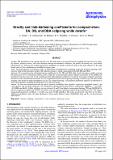Por favor, use este identificador para citar o enlazar a este item:
http://hdl.handle.net/10261/210795COMPARTIR / EXPORTAR:
 SHARE SHARE
 CORE
BASE CORE
BASE
|
|
| Visualizar otros formatos: MARC | Dublin Core | RDF | ORE | MODS | METS | DIDL | DATACITE | |

| Título: | Gravity and limb-darkening coefficients for compact stars: DA, DB, and DBA eclipsing white dwarfs star |
Autor: | Claret dos Santos, Antonio CSIC ORCID ; Cukanovaite, E.; Burdge, K.; Tremblay, Pier Emmanuel; Parsons, S.; Marsh, T. R. | Palabras clave: | Binaries: eclipsing White dwarfs Stars: evolution Planetary systems |
Fecha de publicación: | 2020 | Editor: | EDP Sciences | Citación: | Astronomy and Astrophysics - Les Ulis 634: A93 (2020) | Resumen: | Context. The distribution of the specific intensity over the stellar disk is an essential tool for modeling the light curves in eclipsing binaries, planetary transits, and stellar diameters through interferometric techniques, line profiles in rotating stars, gravitational microlensing, etc. However, the available theoretical calculations are mostly restricted to stars on the main sequence or the giant branch, and very few calculations are available for compact stars. Aims. The main objective of the present work is to extend these investigations by computing the gravity and limb-darkening coefficients for white dwarf atmosphere models with hydrogen, helium, or mixed compositions (types DA, DB, and DBA). Methods. We computed gravity and limb-darkening coefficients for DA, DB, and DBA white dwarfs atmosphere models, covering the transmission curves of the Sloan, UBVRI, Kepler, TESS, and Gaia photometric systems. Specific calculations for the HiPERCAM instrument were also carried out. For all calculations of the limb-darkening coefficients we used the least-squares method. Concerning the effects of tidal and rotational distortions, we also computed for the first time the gravity-darkening coefficients y(lambda) for white dwarfs using the same models of stellar atmospheres as in the case of limb-darkening. A more general differential equation was introduced to derive these quantities, including the partial derivative ( partial differential ln I-o(lambda)/ partial differential ln g)(Teff). Results. Six laws were adopted to describe the specific intensity distribution: linear, quadratic, square root, logarithmic, power-2, and a more general one with four coefficients. The computations are presented for the chemical compositions log[H/He] = -10.0 (DB), -2.0 (DBA) and He/H = 0 (DA), with log g varying between 5.0 and 9.5 and effective temperatures between 3750 and 100 000 K. For effective temperatures higher than 40 000 K, the models were also computed adopting nonlocal thermal equilibirum (DA). The adopted mixing-length parameters are ML2/alpha = 0.8 (DA case) and 1.25 (DB and DBA). The results are presented in the form of 112 tables. Additional calculations, such as for other photometric systems and/or different values of log[H/He], log g, and T-eff can be performed upon request.© ESO 2020 | Versión del editor: | http://dx.doi.org/10.1051/0004-6361/201937326 | URI: | http://hdl.handle.net/10261/210795 | DOI: | 10.1051/0004-6361/201937326 | ISSN: | 0004-6361 |
| Aparece en las colecciones: | (IAA) Artículos |
Ficheros en este ítem:
| Fichero | Descripción | Tamaño | Formato | |
|---|---|---|---|---|
| IAA_2020aa37326-19.pdf | 658,16 kB | Adobe PDF |  Visualizar/Abrir |
CORE Recommender
SCOPUSTM
Citations
29
checked on 25-abr-2024
WEB OF SCIENCETM
Citations
30
checked on 28-feb-2024
Page view(s)
123
checked on 29-abr-2024
Download(s)
62
checked on 29-abr-2024
Google ScholarTM
Check
Altmetric
Altmetric
NOTA: Los ítems de Digital.CSIC están protegidos por copyright, con todos los derechos reservados, a menos que se indique lo contrario.
